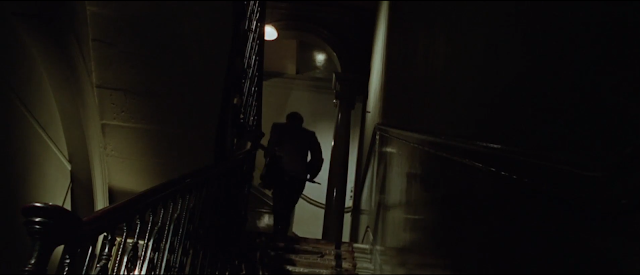Wow!
Over the years I've only caught snatches of this while flipping channels. Yesterday I finally aught it at the beginning and I was blown away by this very stylistic Spy Noir.
The first Spy film was a British silent film called The German Spy Peril (1914). Classic Noir director Fritz Lang in 1928 made the film Spies. It contained a secret headquarters, and spies with numbers instead of using their real names.
Spy Noir from the Classic Noir period include Journey Into Fear, The House on 92nd Street, Ministry of Fear, This Gun for Hire, Pickup on South Street, Hangmen Also Die!, even Gilda had a spy connection.
Dan Hodges on his Film Noir File blog has devoted a whole piece to Spy Noir in Spy Noirs & the Origins of Film Noir in the UK & US Dan discusses how Spy Noir were being produced before the lead up to WWII. I agree that some of them definitely give off the noir vibe certainly Hitchcock's 39 Steps, Saboteur, and Foreign Correspondent do, and I'm sure there are other good examples. There are also quite a few others that are cheap propaganda programmers. Anyway its an interesting subject to explore.
 |
| Michael Caine as Harry Palmer |
 |
| Guy Doleman as Colonel Ross |
 |
| Nigel Green as Major Dalby |
 |
| Gordon Jackson as Carswell lt. |
 |
| Sue Lloyd as Jean |
Starring Michael Caine as Harry Palmer, Guy Doleman as Colonel Ross, Nigel Green as Major Dalby, Sue Lloyd as Jean, Courtney, Gordon Jackson as Carswell, Aubrey Richards as Dr. Radcliffe, Frank Gatliff as Eric Grantby (Bluejay). Thomas Baptiste as Barney, Oliver MacGreevy as Housemartin, Freda Bamford as Alice, Pauline Winter as Charlady, Anthony Blackshaw as Edwards, Barry Raymond as Gray, David Glover as Chilcott-Oakes, Stanley Meadows as Inspector Keightley, Peter Ashmore as Sir Robert, and Michael Murray as Raid Inspector.
The UK. 1965. Radlciffe. Scientist. Kidnapped from train. Security agent killed.
 |
| Aubrey Richards as Dr. Radcliffe |
Military Defense Ministry. Colonel Ross in charge. He needs a replacement. He picks Harry Palmer. Army Sargent. Just recently out of the barbed wire hotel. Crime. Scamming Allied forces in Berlin. Now working for Ross doing stakeout surveillance.
Harry Palmer. Wise guy. Likes birds, cooking, and Mozart. Ross assigns him to the security section under Major Dalby. Dalby. A martinet. By the book Douchebag.
Dalby assigns his section the task of finding the chief suspect in the snatch Eric Grantby code name "Bluejay" along with his "muscle" codename "Housemartin."
Harry reports back to Dalby that he's located Grantby. Dalby assigns Harry to work with Jock Carswell. Housemartin is arrested later by the Metropolitan Police, Harry and Jock arriving at the police discover that Housmartin has been killed in his holding cell by two men impersonating themselves.
Harry suspects that Radcliff is being held in the abandoned factory near the site of the parking tickets and orders a raid. Nothing is found but a partially burned audio tape marked IPCRESS. The tape plays unusual noise when played back.
Things go Noirsville when Carswell is shot and Harry is kidnapped and eventually brainwashed.
Noirvsille
The Ipcress File was one of the more notable films that used the Techniscope system developed in Rome.
"....the 35mm camera needed modification for shooting the Techniscope system. The movement was changed to expose a two-perforation area instead of the normal four-perf. pull-down configuration. In addition, the camera aperture was changed to 1 : 2.35 along with the viewfinder markings. A re-centring of the lens axis was not necessary with this system. Mitchell, Arriflex and Eclair, among others, produced these modified cameras. The two perf. pull-down meant another significant advantage of Techniscope, because the film stock now lasted twice as long as the equivalent length required for normal 35mm cameras.
On a specialized optical printer, Technicolor added a 2 x 1 anamorphic squeeze and, at the same time, optically 'blew up' the half-frame image to the full, 4 perf., anamorphic format. It could then be projected in the same way as regular CinemaScope/anamorphic films in virtually any cinema around the world. Despite this 50% enlargement of the image, Techniscope was usually clearer and sharper than CinemaScope at the time. It was ironic that it performed better than the system it tried to emulate. While the laboratory work was slightly more expensive than normal, production costs in film stock were cut in half. And there were further savings by avoiding the need to hire the more expensive anamorphic camera lenses." (History of Techniscope:)
Michael Cane gives an excellent performance as Palmer. Nigel Green plays Dalby as if he's got a ramrod up his ass. Guy Doleman plays Minister Ross appropriately shifty. Sue Lloyd plays cool and standoffish. All this is masterfully directed with an exciting Noir visual style that is edited flawlessly. 8/10



























































No comments:
Post a Comment